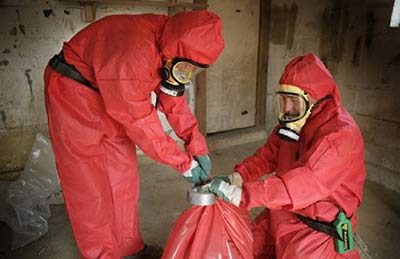asbestos removal
Strada Environmental Ltd can boast a diverse customer base covering all locations in not only Scotland but the UK also. We are an approved asbestos removal contractors for many of the local authorities, colleges and universities, health boards, MOD service providers, construction companies and house builders. We pride ourselves in the quality of service we provide, the speed at which we respond to enquiries and the no nonsense, straight forward approach we take with every job that we do.
No job is too small and we are happy to process enquiries from domestic and large commercial customers.
Asbestos Removal works fall into three categories
- Licensed Asbestos Work
- Notifiable Non Licensed Work (NNLW)
- Non Licensed Work
Whether a type of asbestos work is either licensable, NNLW or non-licensed work has to be determined in each case and will depend on the type of work you are going to carry out, the type of material you are going to work on and its condition. The identification of the type of asbestos-containing material (ACM) to be worked on and an assessment of its condition are important parts of your risk assessment, which needs to be completed before you start work.
The difference between these categories are as follows
Licensed Asbestos Work
Most asbestos work must be undertaken by a licensed contractor but any decision on whether particular work is licensable is based on the risk.
Licensable work with asbestos is work:
- where worker exposure to asbestos is not sporadic and of low intensity; or
- where the risk assessment cannot clearly demonstrate that the control limit will not be exceeded i.e. 0.1 asbestos fibres per cubic centimetre of air (0.1 f/cm3); or
- on asbestos insulation or asbestos insulating board where the risk assessment demonstrates that the work is not short duration work; or
Classification of the asbestos containing material is a key factor in risk assessing if a license to remove asbestos is required.
Licensed Asbestos Removal Works are notifiable to the Health and Safety Executive 14 days before the works commence.
Notifiable Non Licensed Work (NNLW)
If the work is exempt from the need for a licence, you then need to determine if it is notifiable non-licensed work or non-licensed work. The key factors to consider are:
The type of work you are planning to do:
- Maintenance, e.g. drilling holes to attach fittings or pass cables through, painting, cleaning etc. Maintenance includes some removal where it is incidental to the main task, e.g. removing an asbestos ceiling tile to allow inspection; or
- Removal, e.g. as part of a refurbishment or redesign project; or
- Encapsulation, e.g. work to enclose or seal asbestos materials in good condition; or
Air monitoring and control, and the collection and analysis of samples.
The asbestos type:
- Is it friable? – the more friable a material is, the more likely it will release asbestos fibres when worked on and the greater the risk of exposure. Work which disturbs more friable materials e.g. asbestos insulation will tend to be NNLW and work which disturbs the least friable materials e.g. asbestos cement can normally be treated as non-licensed work; and
- How firmly is the asbestos bonded in a matrix? (For removal work only) – Asbestos containing materials (ACMs) where the asbestos is coated, covered or contained within another material, such as cement, paint or plastic are considered to be firmly bonded in a matrix, ACMs of this type in good condition can usually be treated as non-licensed work but where they are significantly damaged, and so more likely to release fibres, they will need to be treated as NNLW.
The material’s condition:
- Has the material been damaged or is it in poor condition? – removal of ACMs in poor condition e.g. due to flood or fire damage, will normally need to be treated as NNLW; and
- Will the materials’ matrix be destroyed when worked on? – e.g. deteriorating textured decorative coatings e.g. ‘Artex’ with gel or steam to remove it, will normally need to treated as NNLW.
NNLW work is notifiable to the Health and Safety Executive prior to works commencing.
Non Licensed Work
To be exempt from needing a licence i.e non licensed work the work must be:
- Sporadic and low intensity – to be considered sporadic and low intensity the concentration of asbestos in the air should not exceed 0.6f/cm3 measured over 10 minutes; and
- Carried out in such a way that the exposure of workers to asbestos will not exceed the legal control limit of 0.1 asbestos fibres per cubic centimetre of air (0.1 f/cm3); and
Meet at least one of four other conditions:
- It is a short non-continuous maintenance task, with only non-friable materials (friability describes how likely an ACM is to release asbestos fibres when worked on, so non-friable materials will only release a small number of fibres during work); or
- It is a removal task, where the ACMs are in reasonable condition and are not being deliberately broken up, and the asbestos fibres are firmly contained within a matrix, e.g. the asbestos is coated, covered or contained within another material, such as cement, paint or plastic; or
- It is a task where the ACMs are in good condition and are being sealed or encapsulated to ensure they are not easily damaged in the future; or
- It is an air monitoring and control task to check fibre concentrations in the air, or it’s the collection and analysis of asbestos samples to confirm the presence of asbestos in a material.
All non-licensed and notifiable non-licensed work with asbestos needs to be carried out with the appropriate controls and training in place, to protect those doing the work (and others in the area) from the risks to health that exposure to asbestos causes.






